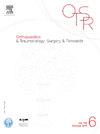Spacers in two-stage strategy for periprosthetic infection
IF 2.3
3区 医学
Q2 ORTHOPEDICS
引用次数: 0
Abstract
In two-stage revision of infected implants, the first stage involves removing the implant and implanting a joint spacer, and the second stage involves implanting a new prosthesis at least 6 weeks later. Spacers have two main functions: local administration of high-dose antibiotics, and preservation of the joint space by reducing soft tissue retraction and improving patient comfort until reimplantation. The present review aims to detail the necessary characteristics of antibiotics added to cement to achieve good joint diffusion, to describe the steps of two-stage revision, and to present the types of spacer available according to the joint and complications.
The antibiotic used in the spacer must be heat-resistant, water-soluble and chemically stable in the cement. Gentamicin and vancomycin are generally preferred. We recommend at least 3 months’ systematic antibiotic therapy for periprosthetic joint infection. Reimplantation is performed either at 6 weeks without antibiotic washout or 3 months after 2 weeks’ washout
Spacers may be static (non-articulating) or dynamic (articulating). Static spacers are mainly used in the knee or hip in cases of severe bone defect or risk of soft-tissue lesions. An articulating spacer enables some joint functions to be preserved in the knee, hip or shoulder.
The most frequent complications are the dislocation of dynamic spacers and the breakage of static or dynamic spacers. To optimize efficacy and minimize complications, the biomechanical and bacteriological characteristics of spacers must be considered.
Level of evidence
Expert opinion.
假体周围感染的两阶段策略中的间隔器。
在感染假体的两阶段修复中,第一阶段包括移除假体并植入关节垫片,第二阶段包括至少6周后植入新的假体。隔离器有两个主要功能:局部给药大剂量抗生素,以及通过减少软组织内陷和改善患者舒适度来保护关节空间,直到重新植入。本综述旨在详细介绍骨水泥中添加抗生素以实现良好关节扩散的必要特征,描述两阶段翻修的步骤,并根据关节和并发症介绍可用的隔离剂类型。隔离剂中使用的抗生素必须是耐热的、水溶性的,并且在水泥中具有化学稳定性。一般首选庆大霉素和万古霉素。我们建议对假体周围关节感染进行至少3个月的系统抗生素治疗。在没有抗生素冲洗的6周或冲洗2周后3个月进行重新植入垫片可以是静态的(无关节)或动态的(关节)。静态垫片主要用于有严重骨缺损或有软组织损伤风险的膝关节或髋关节。关节垫片使膝关节、髋关节或肩部的某些关节功能得以保留。最常见的并发症是动态垫片脱位和静态或动态垫片断裂。为了优化疗效和减少并发症,必须考虑间隔器的生物力学和细菌学特性。证据级别:专家意见。
本文章由计算机程序翻译,如有差异,请以英文原文为准。
求助全文
约1分钟内获得全文
求助全文
来源期刊
CiteScore
5.10
自引率
26.10%
发文量
329
审稿时长
12.5 weeks
期刊介绍:
Orthopaedics & Traumatology: Surgery & Research (OTSR) publishes original scientific work in English related to all domains of orthopaedics. Original articles, Reviews, Technical notes and Concise follow-up of a former OTSR study are published in English in electronic form only and indexed in the main international databases.

 求助内容:
求助内容: 应助结果提醒方式:
应助结果提醒方式:


